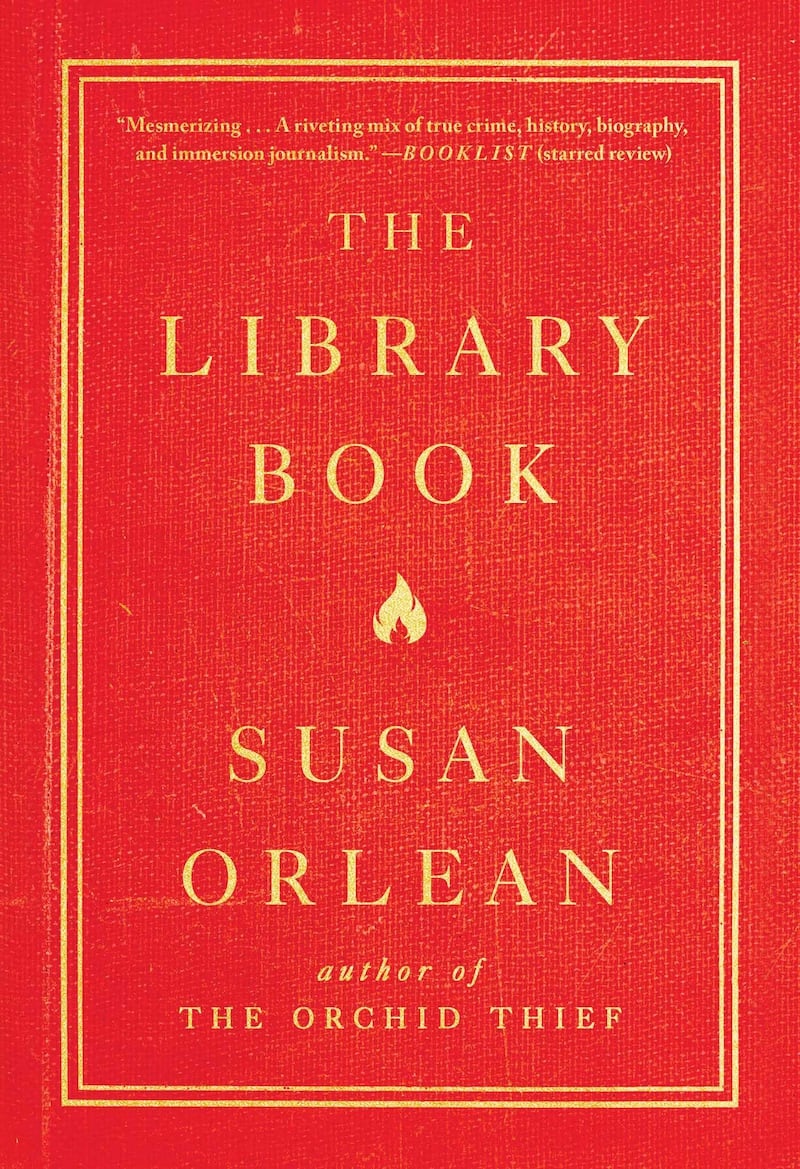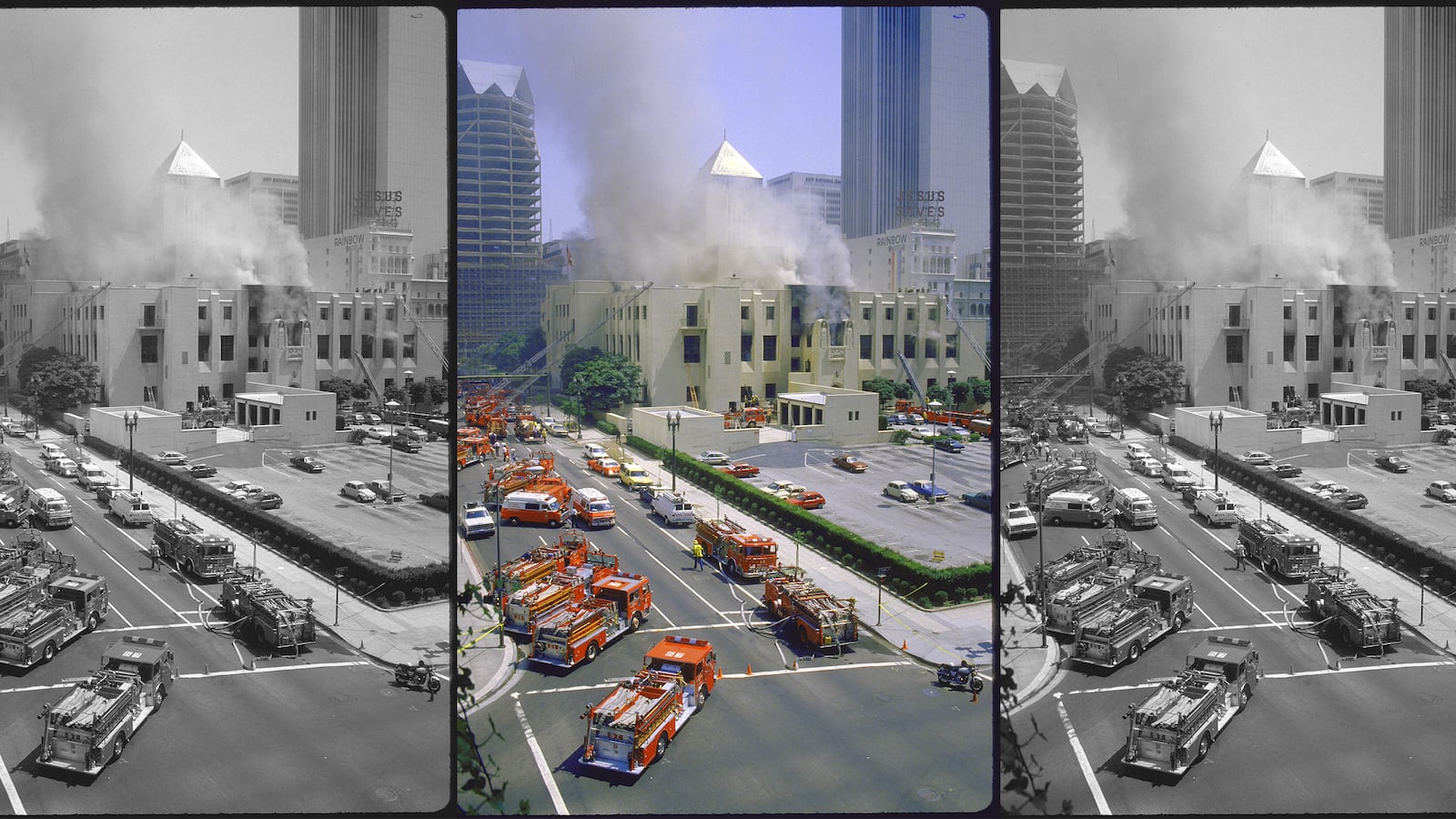Susan Orlean had recently moved to Los Angeles and was taking a tour of the main branch of that city’s public library when the man guiding her around took a book off a shelf, cracked it open, and smelled it. “You can still smell the smoke in some of them,” he said, to which Orlean responded, “Because the library used to let patrons smoke?”
“No,” he said, “smoke from the fire.”
“The fire?” asked Orlean. “What fire?”
That’s when the best-selling author of The Orchid Thief (made into the film Adaptation) and other books first learned about the April 29, 1986 fire that destroyed the main branch, burned or damaged more than one million books, and became the largest library fire in American history.
“I had begun thinking about writing a book about libraries before that,” says Orlean, whose new work of non-fiction, The Library Book, is not just the story of the L.A. fire but a history of libraries, library fires, the sometimes eccentric characters who founded and ran the LA library system over the years, and the inconclusive investigation into who, or what, was responsible for the 1986 conflagration.

“Writing about a library was percolating” when she heard about the fire, says Orlean. “I began thinking libraries are remarkable places. The concern I had was what’s the narrative? I wasn’t sure if I could come up with one, so when I heard about the fire, it seemed to be the perfect opportunity to write about this place. The library was dying a symbolic death at the time it was torched. It was in bad shape. The building had been deteriorating physically, and there were people doubting we even needed libraries.”
But researching her book, Orlean soon realized that she didn’t want to write a whodunit, because the story of the fire touched so many other issues. “To appreciate the meaning of the fire, you needed context,” she says, “the moment in time when it occurred. My goal was not just to tell a crime story; I wanted to write about libraries and what they mean to us.”
And that meant writing about what going to the library as a child meant not only to Orlean but millions of kids like her. “There is something about going to the library as a child that is really magical,” she says. “It’s because there is no money involved, and you can take books off the shelf and bring them home. You feel completely empowered as a kid; you want something, you can have it. And libraries are one of the places where we go and have independence for the first time; you can wander around, it’s a safe environment.”
The Library Book is no mere compendium of personal reminiscences. It’s filled with fascinating tangents that range from a description of the LA main branch’s contents at the time of the fire (including 4,000 documentary films and the programs of every play produced in the city since 1880) to the definition of a stoichiometric fire condition (in which a fire totally consumes all of what is burning, a rare occurrence that happened during the library fire) to a history of the public library movement in the U.S., which was given a huge boost by philanthropist Andrew Carnegie, who launched a library building project in 1890 that eventually built 1,700 libraries in 1,400 communities.
Still, the core of the book is about the fire and a wannabe actor and attention-starved serial liar named Harry Peak who, says Orlean in the book, “could pass for the younger brother of Jon Voight,” and was suspected of setting the blaze in a fit of pique, after a run-in with a security guard in the building. Yet even though he was arrested for the crime, charges were eventually dropped, and the cause of the conflagration remains unsolved to this day.
Not that there aren’t plenty of opinions. The library had no sprinklers and was built in 1926, before the development of fire resistant doors. For years, it had multiple fire code violations, such as blocked exits, exposed light bulbs, and frayed electric cords. Despite this, investigators almost immediately assumed the fire was caused by arson, even though, as Orlean explains in detail in her book, arson is an extremely difficult crime to prove forensically.
“There was a long period of time when I was convinced the cause was faulty wiring misinterpreted as arson,” says Orlean. “Then the more I read Peak’s alibis [which changed multiple times] they began to fall apart, and I came around to thinking he had not intended to do the damage he did; that he did strike a match and started a small fire that got away from him. There were simply details about the fire that he couldn’t have known if he hadn’t been there.”
No matter his possible intentions, Peak’s alleged action started a fire that burned for over seven hours, reached a temperature of 2500 degrees, involved more than half the fire fighting resources of the entire city, destroyed 400,000 books, and damaged 700,000 more. The cost to replace the lost books was estimated at over $14 million. Books damaged by the water used to put out the fire were frozen quickly so mold spores couldn’t bloom, and then stored in space made available in giant food company freezers until they could be restored.
Like the Phoenix, the library managed to rise from its ashes. Many books were saved thanks to the freezing process, while others were purchased through donations, a telethon that raised several million dollars, and other sources. In 1988, restoration of the building began, and was completed five years later. Orlean’s book sees this not only as a return to greatness for the central library. It’s also a metaphor for the ways in which libraries have gone from the cusp of irrelevance—in 1979 the head of the RAND corporation said that, thanks to digitization, libraries would soon be obsolete—to the present day, when libraries have become true community centers.
“It’s the Starbucks effect,” says Orlean about this resurgence. “We have become aware of place as an aspect of community. Being in a shared space is very appealing. And we are seeing a world in which an enormous number of people don’t work out of offices, and the library is an ideal place to work. Libraries are taking advantage of this. They have become information centers and gathering places.”






